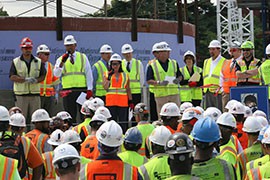Cronkite News has moved to a new home at cronkitenews.azpbs.org. Use this site to search archives from 2011 to May 2015. You can search the new site for current stories.
Stand-downs prevent falling down: Taking a break to focus on safety
WASHINGTON – Workplace safety is Toni DiDomenico’s job, but she’s passionate about it for another reason: 18 years ago, she had to investigate the death of a worker who fell off the back of a rolling truck.
“And still, 18 years later, I can still see his face with the blood behind his head and his blank eyes staring at the sky,” DiDomenico said.
That fatality was the “one-too-many” for DiDomenico who now works to ensure that fall safety is taken seriously at Arizona worksites for Ryan Cos. – one of the businesses that took part this week in a national push to prevent workplace falls.
The U.S. Department of Labor’s National Safety Stand-Down encouraged construction firms to set aside an hour this week to focus on fall safety and to engage in proper procedures to prevent falls – the leading cause of death in the construction industry.
The department estimated that as many as 1 million workers at 25,000 participating businesses took an hour off this week for the stand-down. Several were in Arizona, including the Ryan Cos., where DiDomenico said more than 400 employees, managers and vendors stood down at a worksite at Marina Heights at Tempe Town Lake.
Speakers at the Tempe event included Arizona Division of Occupational Safety and Health employees and the Phoenix-area director of the federal Occupational Safety and Health Administration. Kyle Schoenberger, Ryan Cos. safety superintendent, gave a toolbox talk on fall prevention complete with a trivia contest with prizes for employees.
This week’s event came amid criticism by federal officials of Arizona’s fall-protection regulations for the residential construction industry. In March, OSHA sent a letter to the Industrial Commission of Arizona noting “a number of areas where Arizona’s residential fall protection standards are less effective than federal OSHA’s.”
The major concern was that Arizona required limited, if any, fall protection for employees working between 6 and 15 feet high. OSHA requires the use of conventional fall-protection equipment, such as fall-arrest systems, nets, or guardrails, at heights of 6 feet or higher.
In April, Gov. Jan Brewer signed SB 1307, a bill that set new standards for workplace-fall protection in the state. Some safety provisions were added, but DiDomenico does not believe it fully complies with federal regulations.
“The state of Arizona does not recognize that there are feasible ways to protect employees,” she said.
“It’s a red flag. It’s plain as day that we are not as effective as the federal government,” DiDomenico said.
The law itself contains a provision calling for its automatic repeal if OSHA rejects the state’s changes.
While that process is going on, businesses have taken the lead on spreading the message of fall protection, said Jeremy Bethancourt, program director of Arizona Construction Training Alliance, pointing to this week’s stand-down events.
“It means that employers are willing and know how important it is to train and reaffirm the importance of using fall protections,” Bethancourt said. “It is employers who have taken the initiative to embrace the message of the stand-down and relay that to their employees.”
The Bureau of Labor Statistics reported that seven workers – four of them construction workers – died in falls in Arizona in 2012. Nationally, 269 people died in construction falls that year, the bureau said.
Bethancourt said it worries many construction firms that Arizona’s fall protection guidelines are not in line with those of the federal governments.
And few people know that worry more than DiDomenico, who said she is sometimes hesitant to meet people on a job site, knowing that any one of them could become another fatality.
“You want to minimize the number of people that you meet and speak to because you are increasing your percentages of something happening,” she said.








